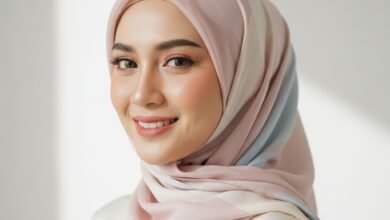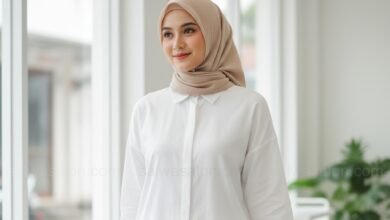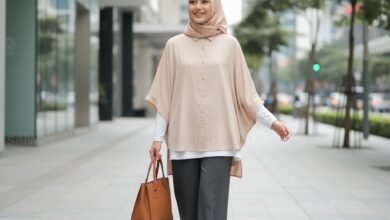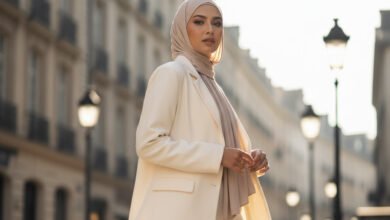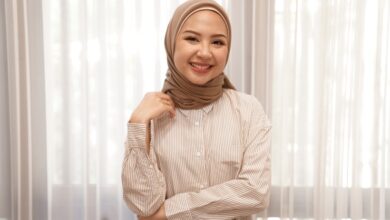8 Anti-Sweltering & Comfortable Hijab Materials for Tropical Climates (2025 Update)

Following viral hijab trends is certainly fun. Beautiful wrapped pashmina styles or luxurious pleated hijab looks can indeed enhance your appearance. However, there’s one big problem often faced by hijab wearers in Indonesia: SULTRINESS. Living in a tropical country with high humidity makes choosing the right hijab material crucial, even more important than the style itself.
Choosing the wrong material not only causes discomfort and excessive sweating but can also trigger hair problems like flatness, musty smell, and even dandruff. Forget complicated styles for a moment; the foundation of all-day hijab comfort starts with a “breathable” material. This article will thoroughly review the 8 best anti-sweltering hijab materials you must own to conquer tropical climates.
Why is a Tropical Climate the “Enemy” of Certain Materials?
Two words: Hot and Humid. Thick, non-sweat-absorbing materials (like thick polyester) will ‘trap’ heat and sweat around the head area. This creates an ideal environment for bacteria to multiply, leading to unpleasant odors and scalp issues. Ideal materials must have good air circulation (breathable) and moisture-wicking capabilities.
8 Best Anti-Sweltering Hijab Materials
- Voile Cotton
Why It’s Superior: The reigning champion for anti-sweltering hijabs. The material is lightweight, cool, and has micro-pores that ensure air circulation. It’s very easy to shape and stand ‘upright’ on the forehead. Drawbacks: Some premium voile types can be a bit stiff initially but will soften after a few washes. Suitable for: Casual square hijabs, formal hijabs, and patterned (printed) hijabs. - Rayon Cotton
Why It’s Superior: Made from natural cellulose fibers, rayon is known for its ‘drapey’ quality and highest sweat absorption. It feels very cool on the skin. Drawbacks: It wrinkles very easily! You must iron it carefully. Suitable for: Casual pashminas, home bergos (instant hijabs). - Japanese Cotton
Why It’s Superior: Best quality cotton. Very cool, sweat-absorbing, colorfast, and has a smooth surface. Drawbacks: Tends to be more expensive than regular cotton. Suitable for: Patterned square hijabs, prayer garments (mukena), or formal hijabs. - T-shirt Material (Spandex/Jersey)
Why It’s Superior: Flexible, practical, and very cool. This material ‘hugs’ the face perfectly without needing many pins. Drawbacks: Can be ‘figure-hugging’ or clearly show the shape of the head/neck if the material is too thin. Suitable for: Sport hijabs, daily bergos, or instant pashminas. - Linen
Why It’s Superior: Made from natural flax fibers, linen is a very strong premium material with the best air circulation. It gives a luxurious ‘rustic’ look. Drawbacks: Very, very prone to wrinkling (but this is part of its aesthetic) and expensive. Suitable for: ‘Statement’ pashminas for OOTD. - Double Hycon (Polly-Cotton)
Why It’s Superior: This is the popular ‘Bella Square’ square hijab material. It’s a blend of cotton and polyester, yet it’s lightweight, easy to shape, and not easily wrinkled. Drawbacks: Not as cool as pure cotton, but still very comfortable for daily wear. Suitable for: Daily square hijabs (for college, work).
Materials to Be Wary Of During Hot Weather
- Ceruti (Baby Doll)
This material is very beautiful, ‘flowy’, and luxurious for pashminas. HOWEVER, it is thin and sheer, so a full ninja inner is mandatory. This means you’ll be wearing two layers on your head, which can feel more sweltering. - Satin / Silk
Very slippery and tends to be hot if the material is thick. This material has minimal air circulation. Use it only for special occasions (parties, graduations) that are short in duration and preferably in air-conditioned rooms.
Tips for Caring for Hijab Materials to Make Them Last & Stay Cool
- Hand Wash (Gentle Rub): Avoid washing machines for voile, ceruti, and rayon materials. Just gently rub with mild detergent.
- Do Not Dry Under Direct Sunlight: Dry in a shady, airy place so colors don’t fade quickly and fabric fibers aren’t damaged (become stiff).
- Iron on Low Heat: For voile and rayon materials, use an iron with a not-too-hot temperature.
Choosing the right hijab material in a tropical climate is an investment in your comfort. With the correct material, you no longer need to worry about sultriness, flatness, or musty smells, and you can focus on your activities with confidence.
Want to know how to overcome flat and dandruff hair problems often experienced by hijab wearers? Read our complete guide here!
